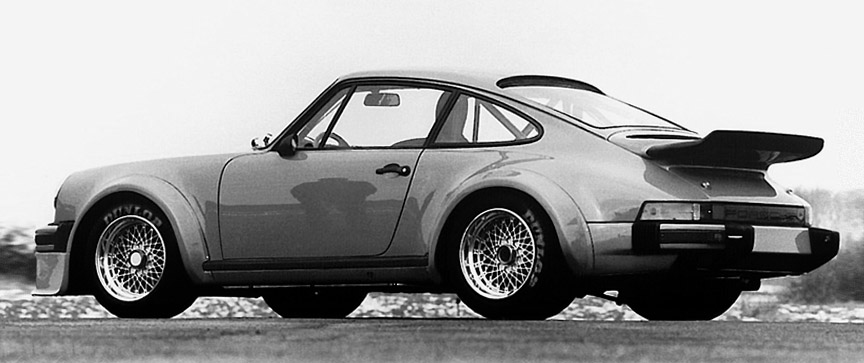Porsche 934 (1976-1977)
Porsche 911 Turbo RSR 3.0
Premiere: February 1, 1976 Daytona 24 hours / Engine: 3.0 flat-6 turbocharged with air-to-water intercoolers / Gearbox: 4-speed / Predecessor: Porsche 911 Carrera RSR 3.0 / Successor: Porsche 924 Carrera GTR
Using the 930 Turbo as a basis, Porsche built the 934 for Group 4 GT racing. It replaced the outgoing Carrera RSR while winning GT Championships in Europe and performing very well in America for Trans Am.
Porsche built the 934 from a standard 930 bodyshell and production rear spoiler, but almost nothing else was left alone.
The 911 Turbo RSR 3.0 was homologated thanks to the G-model 911 Turbo 3.0 aka the Porsche 930. Made for the Group 4 racing, the car was internally called as 934, thus the name. With coefficient of 1.4 or +40% for turbocharged cars, the 3-litre turbo engine was considered to put out the power similar to a 4.2-litre naturally aspirated engine. Considering the 911 Carrera RSR 3.0 had 246 kW and the 911 Turbo RSR 3.0 has 357 kW, the difference is 45%. Naturally, with the turbocharged cars the power depended on how much you dared to raise the boost pressure, so 357 kW was the starting point. For comparison, the street legal 911 Turbo had 191 kW in Europe and the Turbo Carrera 180 kW in USA. So, the Turbo RSR had twice the power of the Turbo Carrera.
The minimum weight set for the Turbo RSR by the rules was high, so the car retained power windows and full door panels like in the 911 Turbo. The dashboard is a simpler spartan piece, though. In the centre of the dash is a prominently placed turbo boost pressure regulator knob. The car was naturally fitted with the safety cage and a bucket seat for the driver. The car also had a fire extinguishing system with lines distributed throughout the cockpit. In order to meet the minimum weight, even ballast had to be added. It was the heaviest racing car Porsche had built.
A 120 liter fuel tank filled the front trunk along with an oil tank and battery. The oil tank fed a front mounted oil cooler which was fed from a huge cut-out in the spoiler. Beside these were ducts that led to the rear intercoolers. This system added nearly 45 lbs to the car, but was necessary since an air-to-air intercooler could not fit under the standard engine hood which was mandated by the regulations.
The engine room is completely different compared to the 911 Turbo. Porsche took the standard 930/75 engine and fitted new pistons while the block, crankshaft and connecting rods were all production parts. Furthermore the standard ignition and mechanical injection system had to be used. There are the water-cooled intercoolers on top of the engine and the engine fan is also mounted horizontally on top of the engine. The exhaust gases exit straight through the turbocharger and the wastegate, there is no muffler. With a large KKK turbocharger, around 485 bhp was possible at 1.4 bar of boost. There were a few sets of gear ratios available. For example, one set gave the following speeds in gear: 1st 70 mph / 113 km/h and 2nd 99 mph / 159 km/h! Redline was set at 7000 rpm.
The suspension was converted to solid mounts and nylon bushings with adjustable anti-roll bars. New brakes from the 917 were fitted along with stronger hubs and BBS center-lock wheels which at 16 inches, were larger than the outgoing the RSR and required more drastic wheel arches.
The first 934 prototype appeared in September of 1975 and it was instantly faster than the outgoing Group 5 Carrera RSR 3.0. This meant almost every team upgraded to the 934 including Kremer and Gelo. As a result the car was very successful in the European GT Championship which was won by Toine Hezemans (100 points) in the Gelo car. He was followed by Helmut Kelleners and Tim Schenken (both 57 points). The same could be said about the German GT Championship which effectively became a Porsche-only affair.
Later in production Porsche released a 934½ specification which included a larger rear wing and updated 930/73 engine which could produce 600 bhp. These were primarily raced in Group 5 and many were used in America for Trans Am duty under the Vasek Polak banner. They dominated the 1976 season with George Folmer behind the wheel and in 1977 Peter Gregg won the championship. By 1977 the 934 was finally accepted by IMSA and many of those cars were updated to Group 5 spec. At Le Mans, the 934 was a regular fixture and competed against the Ferrari 512 BB LM. They took class honors in 1977, 1979 and 1981.
The single-turbo cars, whether 934 or 935, were a handful with all that turbo lag. Jackie Ickx told me to commit the car to the corner and saw away at the steering wheel to scrub off the speed whilst not lifting your right foot. – Racer Nick Faure recalls getting insights from Ickx
Porsche 934/5
In order to convert Group 4 934 into a Group 5 car, it was fitted with wider wheels, wider rear wheel arches and the wing from the 935. These 934/5 cars were first seen at the 1976 Nürburgring 1000 km race, where Toine Hezemans/Tim Schenken scored second. By 1977, most of the 934 were modified to 934/5. From mid-season 1977, many 934/5 were even fitted with boxed rear fenders from 935. Learn more in our in depth guide.
Pictures & Details
























